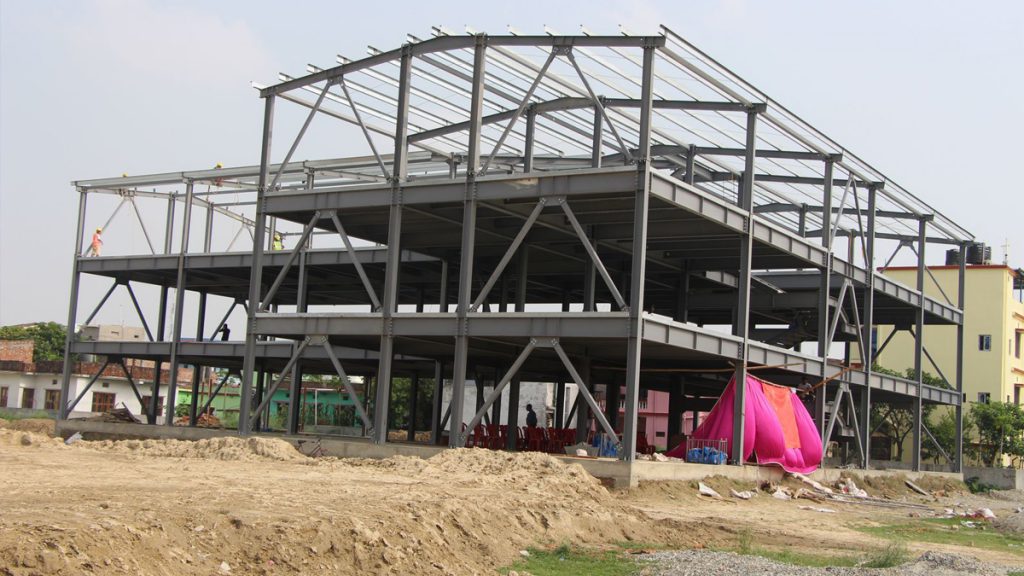Making anything fire resistant or incombustible is referred to as fireproofing. It may be an entire structure, a particular material, or individual building components. This is an example of a passive fire safety measure. Construction uses a variety of fireproofing techniques. It is important to remember, even though the products labeled as “fireproof” are not resistant in every circumstance. In other words, objects can be harmed by fire that exceeds the intensity or duration for which it was designed.
Fireproofing in Steel Frame Construction
Building fires usually exceed temperatures of around 2,000°F, while structural steel melts at around 2,500°F. While the probability of steel melting is uncommon, this does not mean that steel structures are risk-free. When exposed to high temperatures, the material deforms and loses strength. As a safety measure, building codes require structural steel to be fireproofed. Steel fireproofing ensures that a structure maintains its shape in the event of a fire, allowing people to flee in an emergency. Commercial structural steel should, among other things, reach the 2-hour fire resistance rating. The most popular ratings are two, three, and four hours.
Method for Fireproofing Structural Steel
As a safety measure, many buildings codes require structural steel to be fireproofed. Spraying low density fiber, now known as spray applied fire resistance material, is the most effective method of providing such protection (SFRM). Heat resistance can be achieved by spraying the substance on concrete, but it can also be used on wood, cloth and other building materials. The thickness of the coat that must be applied is dictated by building codes. Spray products are classified as either wet spray or dry spray, depending on how they are combined and applied. However, sprays aren’t the only choice. There are other alternatives depending on the circumstances. However, sprays are widely used and are worth considering. Sprays are the most popular, but they aren’t the only choice.
Intumescent Coatings
These coatings, also known as intumescent paints, provide steel members with fire resistance. Intumescent coatings can expand up to 100 times their original thickness, increasing resistance by acting as a barrier between a steel element and the fire. When exposed to intense heat, the coatings will undergo a chemical reaction and expand. When it comes to steel that is exposed to the general public, intumescent coatings are a perfect option. Every layer of the product adds to the total thickness of the product, just like paint. This fireproofing material can also be used to protect structural wood.
Flexible Blanket Systems
Flexible blankets may be used as a fireproofing material and are made for particular needs. Despite the fact that it is a very practical and convenient process, there are only a few manufacturers. Almost all safety regulations and codes are met with this system. It creates a reliable barrier that keeps fires from spreading to structural members while maintaining toxic-free environment. This application complies with nearly all safety requirements and regulations, resulting in a cost-effective and dependable framework for preventing structural fires. When dealing with complex shapes, blanket systems can be a good choice.
Rigid Board Fireproofing
Rigid board fireproofing is simple and easy to install. Moisture-resistant, these boards provide fireproofing, thermal insulation, and acoustic control. One of the advantages is that it can be assembled when steel decks and beams are being installed. Rigid board fireproofing meets all fireproofing specifications while also providing thermal and acoustic insulation. Pests and termite attacks are deterred by this form of fireproofing. It’s also available in a variety of thicknesses to reach UL standards, and it can withstand moisture and humidity without losing its fire-stopping properties. Boards can be made to exact specifications and with decorative finishes.
Autoclaved Aerated Concrete
When used around steel columns, autoclaved aerated concrete will enhance and provide fire resistance. When mounted between the flanges and tied to the network of rolled parts, this provides fireproofing properties. Pouring concrete between the flanges of the steel components using shear connections attached to the steel web can be helpful when longer fire resistance requirements are needed. At the bottom of the connection section, the concrete that is being placed must be maintained.
Concrete
Encasing large pieces of steel in concrete is a less popular choice than it once was, but it can be useful for certain projects. Because of the amount of concrete used, this takes up more room and is less aesthetically appealing than other alternatives. Large parking garages, for example, are less concerned with these factors, so they can still use this method. Additional fire protection can be provided such as rebar, between the flanges that are kept in place by concrete.
In case of a fire outbreak, structural steel fireproofing can create a huge difference between a building’s entire structure being damaged and being collapsed completely. Active fire safety, such as fire sprinklers, is supplemented by passive fire protection, which makes buildings secure for residents while still preserving the owner’s investment.

